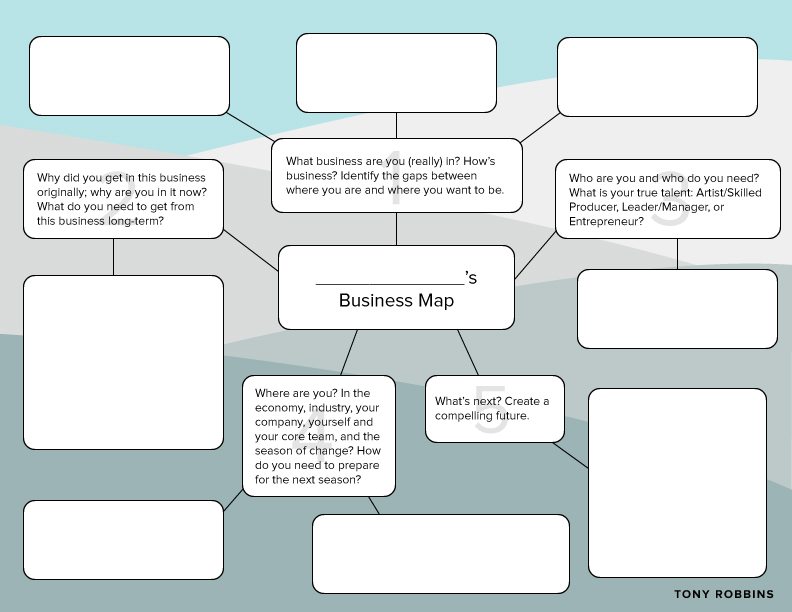What you will get from this article:
- Gain answers to the question “how to grow my business”
- Learn 3 key business growth strategies for your company and yourself
- Understand how to identify where your business is at and where you want it to be
- Discover the difference between a business plan and business map
- Find a concrete way to create your own business map
If you’re a business owner, it’s likely the following statement has crossed your lips at least once: “I need to learn how to grow my business!” Chances are you’ve thought about making a business plan. Or maybe you already have one… on the back of a napkin. Somewhere. Or maybe you’ve read up on business growth strategies but don’t know how they apply to your field. You might go on to create a great-looking business plan, but when you go to execute the steps, nothing seems to work.
Does this mean that you should just not try and make a forward-looking document for your business? Of course not. But instead of thinking about a business plan, let’s consider a business map. More flexible, a business map can help you understand not only where you are today, but where you’re trying to go with your company. The result: a clear vision of how to make your business grow.
JUST WHAT IS A BUSINESS ANYWAY?
Let’s clear the air with some terms. In opening or running a business, your goal is to create a sustainable system that allows you to consistently increase the quality of your life and the lives of the people you serve. Ultimately a business can mean freedom and fulfillment. The challenge? Most people get caught up in the vehicle instead of the outcome. If your business is organized around meeting your needs, not your customers’, then you have a job, not a business. Understanding this distinction is critical to learning how to make your business grow, since it won’t grow unless you master both external and internal business relations.
BUSINESSES HAVE A NARRATIVE, AND SO DO YOU
Everyone has a chronological timeline of events that comprise our personal histories, a type of narrative detailing our experiences and the value we inherently assign to those experiences. One of Tony Robbins’ core philosophies is that the stories we tell ourselves define us.
What does this have to do with business growth strategies? If you’re asking “how to grow my business,” you’re in a position of opportunity. The series of events leading to this point is subject to your narrative, as are current and even future events. Since your inner dialogue influences every decision, including your business decisions, it is critical that you master the art of framing your experiences so that they they enhance your state instead of dampening it.
The same logic applies to businesses. A series of events led to the business’ “birth” and current stage of growth. Those events are subject to interpretation by your narrative, so you must work diligently to frame your business’ life cycle in a way that creates effective business growth strategies. Creating a business map provides a narrative, an interactive version of your business’ timeline while clarifying the purpose and goals of the business. If the stories we tell ourselves define us, your business map will tell a story of authenticity, purpose and drive, which become the hallmarks of your business.
WHY A BUSINESS MAP, NOT A BUSINESS PLAN?
In today’s world, a business plan just isn’t realistic. Things change so fast in the working world that by the time you’ve created your business plan, you have to start all over again. What’s the point of that? You’re already mulling over the “how to grow my business” question, and having an outdated business plan doesn’t provide any clarity. You need some sure-fire business growth strategies.
With a business map, you have something that can guide you from where you are right now to where you want to go. This feature reflects the narrative qualities of a business map, since it provides a level of real-time interactivity. While maps show the most efficient route and all the obstacles, one key issue with maps is that they are only useful if you know where you are.
Once you have your map, you have to remember to update it constantly. Because we are in an environment that is continuously changing, you have to adjust your map accordingly to stay ahead of the game. Think about how frustrating it is when Google Maps doesn’t update to include a new business or permanent street closure – your business map works the same way. Keep your map up-to-date and you’re able to get where you want to go.
HOW TO MAKE A BUSINESS MAP
Do you find yourself asking, “How am I going to grow my business?” The first step is in making your custom business map. Making a business map starts with answering a series of questions. The more honest you are about where you are, the better able you’ll be to end up at your desired result: business growth strategies that work. Below is an example of a business map so that you can start mapping out your own process.

STEP 1: UNDERSTANDING YOUR BUSINESS
What business are you in?
This question might seem obvious, but drill down a bit deeper. Who are you in your business, and who are you serving? For example, what business is Starbucks in? You might say coffee. But ask Starbucks CEO Howard Schultz and you’ll likely get the story of his trip to Italy. There he saw people eagerly meeting in cafes before and after work. The promise of a transitional meeting place between home and work was the seed that grew into Starbucks. He knew his business was about creating an experience – one that’s consistent worldwide – not just delivering coffee.
If you want to know how to make your business grow, start by truly understanding the “personality” of your company.
What business are you really in? How’s business?
If you understand what your business really is, you can anticipate changes in the market. You’ll see the possible opportunities and threats that you otherwise might overlook.
As an example, think about the U.S. railroad. If railroad companies had understood that their business was transportation, not simply running trains, it’s likely they could have prevented the sharp decline in railroad usage that the trucking industry caused. Knowing what business you’re really in means having a deep and thorough understanding of your customer and the value they gain from you.
What business are you in?
This question might seem obvious, but drill down a bit deeper. Who are you in your business, and who are you serving? For example, what business is Starbucks in? You might say coffee. But ask Starbucks CEO Howard Schultz and you’ll likely get the story of his trip to Italy. There he saw people eagerly meeting in cafes before and after work. The promise of a transitional meeting place between home and work was the seed that grew into Starbucks. He knew his business was about creating an experience – one that’s consistent worldwide – not just delivering coffee.
If you want to know how to make your business grow, start by truly understanding the “personality” of your company.
What business are you really in? How’s business?
If you understand what your business really is, you can anticipate changes in the market. You’ll see the possible opportunities and threats that you otherwise might overlook.
As an example, think about the U.S. railroad. If railroad companies had understood that their business was transportation, not simply running trains, it’s likely they could have prevented the sharp decline in railroad usage that the trucking industry caused. Knowing what business you’re really in means having a deep and thorough understanding of your customer and the value they gain from you.

STEP 2: YOUR ORIGIN STORY
Why did you originally get into this business?
Why are you in it now? What do you need to get from this business in the long term? These questions help you see where you started and where you want to ultimately go. If you can answer these questions honestly, then you’re well on your way to situating yourself accurately on your business map.
Who are you?
Who do you have now as part of your team? Who do you need? Who must you get rid of? Take stock of the assets you have, the assets you lack and what’s holding you back. Again, no business growth strategies work without a full, accurate picture of your current position. The answers might surprise you.
Who is your current client?
This question gets to the heart of your business. Tony talks about creating “raving fans”; these are clients that stick with you and really appreciate your brand, not just the item or service you’re selling, instead of customers that will leave once you’ve met their needs. Also think about who your client needs to be. What does your client need? What is your client going to need? These answers will help you map out the future of your business for maximum growth.
Why did you originally get into this business?
Why are you in it now? What do you need to get from this business in the long term? These questions help you see where you started and where you want to ultimately go. If you can answer these questions honestly, then you’re well on your way to situating yourself accurately on your business map.
Who are you?
Who do you have now as part of your team? Who do you need? Who must you get rid of? Take stock of the assets you have, the assets you lack and what’s holding you back. Again, no business growth strategies work without a full, accurate picture of your current position. The answers might surprise you.
Who is your current client?
This question gets to the heart of your business. Tony talks about creating “raving fans”; these are clients that stick with you and really appreciate your brand, not just the item or service you’re selling, instead of customers that will leave once you’ve met their needs. Also think about who your client needs to be. What does your client need? What is your client going to need? These answers will help you map out the future of your business for maximum growth.

STEP 3: WHERE ARE YOU GOING?
With all the answers you’ve gotten, you can now evaluate where you are. How do you compare to your competitors? Given all that you know, think about where you stand in the grander scheme of things. Are you in an aging industry and need to get out? Are you the clear incumbent, or are you charting completely new territory?
No matter where you are, you have two choices: You can grow or you can die. If you’re not growing, you’re dying. It’s easy to say “I want to understand how to grow my business,” but then what?
Tony says if your why is strong enough, your how will come. And good news: You just laid out your why. You’ve just figured out what business you’re really in and why, what your clients need and why. So now it’s time to figure out the how of business growth, which is the key to mastering business growth strategies.
With all the answers you’ve gotten, you can now evaluate where you are. How do you compare to your competitors? Given all that you know, think about where you stand in the grander scheme of things. Are you in an aging industry and need to get out? Are you the clear incumbent, or are you charting completely new territory?
No matter where you are, you have two choices: You can grow or you can die. If you’re not growing, you’re dying. It’s easy to say “I want to understand how to grow my business,” but then what?
Tony says if your why is strong enough, your how will come. And good news: You just laid out your why. You’ve just figured out what business you’re really in and why, what your clients need and why. So now it’s time to figure out the how of business growth, which is the key to mastering business growth strategies.
WHAT MAKES A BUSINESS GROW? HOW TO GROW MY BUSINESS?
The core of all successful business growth strategies? Adding value.
Seriously, it’s really that simple. Once you understand how to consistently offer more value than anyone else in your market, you’re in a better position to identify where you are now. You’ll also clearly see what it will take to get to where you want to be. You’ll have more certainty about what your business needs to do to grow now, and you’ll be better able to steer your organization in accordance with that vision.
Most importantly, you’ll understand what business you need to be in to become the dominant force in your market.
The core of all successful business growth strategies? Adding value.
Seriously, it’s really that simple. Once you understand how to consistently offer more value than anyone else in your market, you’re in a better position to identify where you are now. You’ll also clearly see what it will take to get to where you want to be. You’ll have more certainty about what your business needs to do to grow now, and you’ll be better able to steer your organization in accordance with that vision.
Most importantly, you’ll understand what business you need to be in to become the dominant force in your market.

